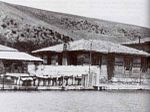SantralIstanbul

The SantralIstanbul (Turkish: Santralİstanbul), opened in 2007, is an arts and cultural complex located at the upper end of Golden Horn in the Eyüp district of Istanbul, Turkey. The center, consisting of an energy museum, an amphitheater, concert halls and a public library, is situated within the Silahtarağa campus of Istanbul Bilgi University that was formerly the first power station of the Ottoman Empire. Arts, cultural, educational and social buildings of SantralIstanbul, having an area of 118,000 m2, are all housed in the facilities of the former Silahtarağa Power Station, which served from 1914 to 1983 for supplying Istanbul with electric power. The site is named after the Turkish word "santral" for power plant.
Excerpt from the Wikipedia article SantralIstanbul (License: CC BY-SA 3.0, Authors, Images).SantralIstanbul
Otoparka götüren yaya yolu,
Geographical coordinates (GPS) Address Nearby Places Show on map
Geographical coordinates (GPS)
| Latitude | Longitude |
|---|---|
| N 41.0665 ° | E 28.9461 ° |
Address
Mimarık Fakültesi
Otoparka götüren yaya yolu
34060
Türkiye
Open on Google Maps






